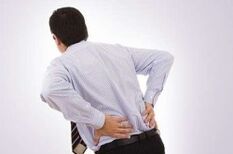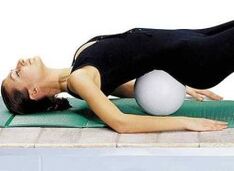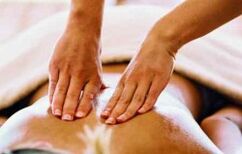With the osteochondrosis of the spine, bone tissue and cartilage of one or more column departments are destroyed.This disease is chronic and develops in almost all older people.This is due to the usual aging of the body.

Intervertebral discs are subject to atrophic changes, and at what age this will happen depends on many factors:
- wounds;
- Diseases and spine overload.
The column overload belongs to:
- Walking with a curved back;
- incorrect seat;
- Characteristics of the structure of the spinal column;
- Insufficient nutrition of column tissues due to hereditary anomalies.
With osteochondrosis, the nucleus located among vertebrates loses part of the water.Because of this, metabolic disorders are altered in the nucleus and several minerals and vitamins are difficult to access.
After a while, cracks appear on the disc, it becomes flat.Then, nearby joints and ligaments begin to be affected, forming tissue inflammation.Due to inflammation, there is a displacement of neighboring rooms.This is dangerous for the appearance of root symptoms: pain along the affected nerve.
The appearance of intervertebral hernia is also possible, and, in turn, can cause compression of the spinal cord.Osteochondrosis is characterized by the appearance of osteophytes: bone growths in vertebral bodies.These growth can squeeze the spinal cord and cause Rooser's syndrome.
Very often, cervical and lumbar parts are subject to osteochondrosis.
Cervical osteochondrosis
Reasons:
- sports activities (heavy athletics);
- Overweight;
- Metabolic violation;
- Sedentary work (programmers, accountants, drivers, etc.);
- flat feet;
- column injuries;
- hypothermia.
Symptoms
The main symptoms of the osteochondrosis of the cervical column are the pain in the head and neck.The person is worried about severe headaches, neck pain, shaking hand, sternum pain.The patient may complain about the shelters: the appearance of acute neck pain, a spasm of the muscle muscles and the restriction of the movement.
In addition, a person can listen to a crunch when he turns his neck.Due to the pinch of nerves and blood vessels, a person can have a numbness of the tongue and fingertips.The patient will complain about a decrease in hearing and vision, increased blood pressure and weakness in the muscles of the arms and legs.
Thoracic osteochondrosis
This type of osteochondrosis is quite rare.This is due to the anatomical structure of the thoracic column.It consists of 12 vertebrae, which are connected to the ribs due to the joints.In front of the ribs are connected by the sternum.Therefore, an excellent frame of the spine, sternum and ribs are created, which protects the internal organs of several lesions.
The vertebrae of the thoracic region have a small height and long and spicy processes that are on the other, like a mosaic.Due to this structure, this column is a small mobility.The intervertebral discs of the thoracic region are rarely injured.
The reasons for the formation of this type of osteochondrosis:
- irrational load distribution;
- delay in the intervertebral disc diet;
- Sedentary work;
- The presence of scoliosis.
Symptoms
As with other types, the main symptom of osteochondrosis of the thoracic region is pain.
But with thoracic osteochondrosis, pain can be different.Dorsalgia: long discomfort and weak pain along the vertebrae of the chest.Pain can affect cervical and lumbar areas.
Dorsago is one of the signs of osteochondrosis of the thoracic region, in which pain occurs in the form of an attack.By nature, it is intense, acute, leads to difficulty breathing, leads to limit muscle movements.In addition to pain, patients may have a feeling of numbness in the chest, the deteriorated sexual function, the pain in the heart, the kidneys and the stomach.
Why is damage to the thoracic region dangerous?
The spine is organized so that in the thoracic region it narrows, so the hernias that occur due to osteochondrosis will quickly lead to the compression of the spinal cord.This will easily lead to heart problems, pancreas, liver and kidneys, because the thoracic region is associated with all these organs of nerve fibers.That is why it is very important to consult a doctor in time.It will help find where the signs of osteochondrosis that bother you and perform a competent treatment of the disease come.
Lumbar osteochondrosis
The osteochondrosis of the lumbar column occurs due to the severity of the elevation.Normally, in the center of the intervertebral disc there is a core that contains a large amount of water.Due to the liquid, the nucleus becomes little compressed, and for its rest 500 kg will be compressed.
However, the album hit by the osteochondrosis weakens, and only 200 kg will be needed to break it.If a person weighing 70 kg lifts 15 kg of load in a folded position, and for the spine is a load of 200 kg, the intervertebral disc can explode.That is why the first symptoms of the column osteochondrosis manifest themselves by raising gravity.
Symptoms
- lumbar pain;
- the impossibility of movement in the lower back;
- deteriorated dream;
- irritability;
- fatigue;
- the impossibility of making domestic needs;
- decrease in sexual function in men;
- Violation of the menstrual cycle;
- Cold leg syndrome.
In the transition from osteochondrosis to the sacral region, the patient has pain in the kidneys and urine.
Diagnosis
The treatment of osteochondrosis is performed by a neurologist.To start, examine the spine, pay attention to the presence of scoliosis.After feeling, the doctor can understand how the spine, tendons and nerves are amazed.
After the neurologist will suspect the osteochondrosis of the spine, he will direct the patient for an additional exam.This includes the approval of the radiological examination, images of magneto-resonance.In case of suspicion of the destruction of the intervertebral disc, the discography is performed.It is also prescribed to determine the degree of damage to nerve paths.
In general, the diagnosis of "column osteochondrosis" is very difficult.After all, a person may complain about pain in the heart, liver, kidneys, pancreas or sexual dysfunction.But still, after a careful exam, an experienced doctor can suspect this disease and prescribe the correct treatment.
Treatment
Osteochondrosis therapy is a very long and severe process.In the acute period, the patient needs the peace of the affected segment.If the Cervical Department is affected, then the patient must use a lutitas fixing necklace.If the lumbar region hurts, the patient needs to rest the bed.It is better to place the patient in a hospital.Only there you can completely observe the designated regime.The bed of such a patient should be difficult.To do this, place a wooden shield under the mattress.
Drug treatment
As mentioned above, the main symptom of the disease is pain.Therefore, an analgesic are prescribed to the patient to relieve pain and other symptoms of osteochondrosis.
Non -steroidal anti -inflammatory medications are also prescribed.
Unfortunately, the prolonged use of these medications causes damage to the mucous membrane of the gastrointestinal tract and the patient has the following symptoms:
- nausea;
- vomit;
- stomach pain;
- Feeling in the stomach.
Gastric ulcer can also exacerbate or gastric bleeding.Therefore, before using these medications, you should consult a doctor.If the pain caused by osteochondrosis lasts 3 months, antidepressants are prescribed along with these medications.It was established that, in addition to a soothing effect, they can reduce pain.
All previous medications can be attributed to symptomatic therapy.They will help relieve pain, but they will not save a person from the disease itself.
To restore intervertebral discs and cartilage, condoprotectors are prescribed.These medications improve metabolism in connective tissue and contribute to cartilage restoration.Drugs take a long period of time, on average - 4 - 6 months.
In addition to restoring tissues and improving metabolism in them, these medications also have an analgesic effect.Another group of medications necessary for the spine osteochondrosis are the medications that improve blood circulation.Its use contributes to the expansion of blood vessels, and if antioxidant preparations are taken in combination with them, then the metabolism of nerve cells will improve in humans.
As with any disease, patients need calcium preparations.It will restore bone tissue activity, increase the resistance of ligaments and tendons, and will also become a prevention of osteoporosis, a disease that accompanies osteochondrosis.

Medical Physical Education
The dosing load in the spine will improve the patient's condition.But you must perform exercises very carefully.In the acute period, physical education classes are contraindicated.Only with the sinking of pain can begin to get involved a bit.
The exercises will improve blood circulation in the spine, strengthen the muscles.Due to the blood flow, the metabolism will improve and begin the restoration of damaged intervertebral discs.But we must also remember that classes must be maintained regularly, otherwise it will not have results.
Exercises for damage to the cervical region
- Lie on your back and straighten.Put a hand on the stomach, and the second in the chest and breathe, raise your breathing for 10 minutes, then exhale and relax.The duration of the exercise is 3 to 5 minutes.Per day you need to perform 3-5 times.
- Lie on the stomach and straighten the legs.Based on the stomach and legs, you must lift your head and the top of the chest.Exercise do 3 - 5 minutes with an interval of 30 seconds.
- Lie on your back and bend your knees.In this position, turn to the right and left side.Exercise do 3 - 5 minutes with an interval of 30 seconds.
Exercises for damage to the thoracic region
- Lie on your stomach.Put your hands on the floor and fold back.Keep in this position for 5-10 seconds.Exercise do 3 - 5 minutes with an interval of 20 seconds.
- Lie on your back.Raise your head and legs up ("boat").I lie for 10-20 seconds.Exercise do 3 - 5 minutes with an interval of 20 seconds.
Exercises for damage to lumbar
- Lie on your back, bend your knees and press on your chest.Turn back and forth and roll from the back to the sacrum and back.Balance up to 2 minutes.Then you need to lie down calmly and relax.
- It is necessary to stop on all fours and bend as much as possible.Exercise do 3 - 5 minutes with an interval of 20 seconds.
- In a standing position, imagine that the hoop rotates for 2 to 3 minutes.Exercise perform 10 times a day.
Surgical treatment
In the absence of the effect of conservative treatment and the appearance of complications of osteochondrosis, surgical treatment is prescribed.During the operation, the stabilization of the spine is performed, the pressure on the spinal cord and the roots is eliminated.If a person has an intervertebral hernia, it is eliminated.Since when performing this operation, damage to the spinal cord and nerves is possible, it is carried out only according to vital indications.
Physiotherapeutic treatment
The appointment of physiotherapeutic procedures positively affects the course of the disease and accelerates the recovery process.With osteochondrosis, it is allowed:

- Visit a sauna or bathroom;
- swimming in the pool;
- massage;
- paraffin therapy;
- manual therapy;
- laser therapy;
- Several bathrooms;
- mud;
- electrophoresis with anti -inflammatory or muscle relaxing drugs;
- Magnetotherapy;
- D 'Arsonval.
All these procedures improve blood circulation in the sick area, allow you to relax the muscles and relax the entire organism.Physiotherapeutic procedures are prescribed in the rehabilitation period, when the patient is not disturbed by severe pain.
Prevention
No one is safe from osteochondrosis.After all, we are all aging, and with us all our body is aging.So that the disease does not destroy its plans, you still need to practice sports from youth.Moderate physical activity helps improve blood circulation, normal metabolism.In addition, it trains muscles that protect the spinal column.For the prevention of osteochondrosis, everyone must:
- Eating correctly: vitamins and minerals necessary for the body;
- abandon bad habits;
- participate in physical education;
- Don't bend down;
- Protect hypothermia back;
- Do not lift objects too heavy;
- Take a contrast shower and harden;
- Avoid stress.
It is especially important that people suffering from this disease follow all recommendations, because their inability to meet an exacerbation.When back pain, which does not pass for a long time, it is necessary to seek help from a specialist.Only a doctor can make a correct diagnosis and prescribe treatment.
Do not harden with a visit to the clinic, because it is better to treat the disease in the early stages.In addition, it is not self -medicated: any medicine has its own contraindications, which may not know.Strictly observe all the doctor's recommendations and then the disease will soon retire!






















